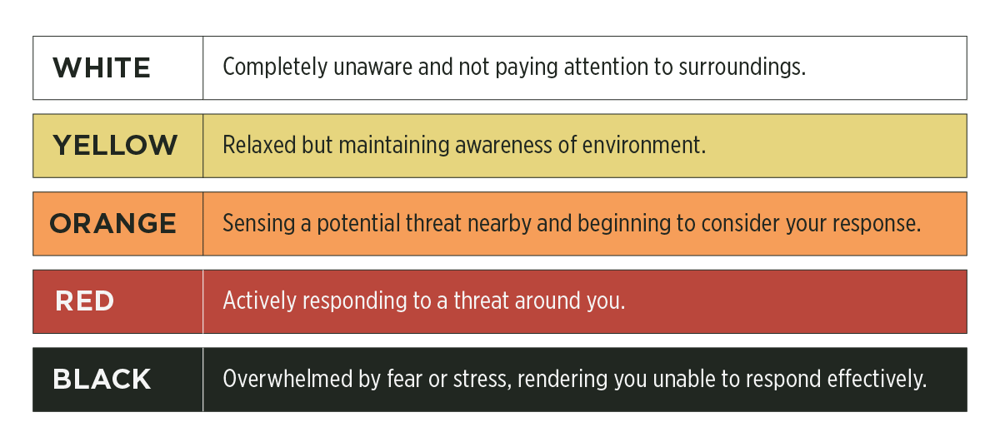Situational awareness isn’t just a nice-to-have trait in the workplace, but a fundamental skill that impacts the success and safety of individuals and organizations as a whole.

| INSIDE THIS ARTICLE, YOU’LL FIND: What is situational awareness? Why situational awareness matters in the workplace How to improve situational awareness: Training and exercise |
In modern workplaces, the ability to navigate complex situations with clarity is invaluable. Artificial intelligence may replace many skills and capacities, but the ability to be aware of your surroundings and know how to react in real-time is still uniquely human. This skill, known as situational awareness, guides us through dynamic challenges. Whether you’re stationed in a bustling office, operating in the field, or traveling to high-risk locations mastering situational awareness allows you to mitigate or avoid threats.
The need for situational awareness extends beyond routine circumstances. In today’s world, crises can erupt unexpectedly, ranging from natural disasters to instances of workplace violence. In such moments, maintaining a clear understanding of one’s surroundings and making split-second decisions can be a matter of life and death. Situational awareness becomes not just a professional skill, but a lifeline.
WHAT IS SITUATIONAL AWARENESS?
Situational awareness is the perception and comprehension of one’s surroundings or situation, coupled with the ability to project future events and make informed decisions based on that understanding.
Situational awareness goes beyond observation: it requires actively perceiving, comprehending, and projecting information to make informed decisions in real-time. Picture a firefighter assessing a burning building, or a project manager leading a high-stakes meeting — though very different situations, both rely on situational awareness to assess risks, anticipate obstacles, and adapt strategies on the fly.
The core components of situational awareness are all different skills that can be trained and improved:
- Perception: This is the ability to observe and gather relevant information from the environment. It involves recognizing sensory cues such as sights, sounds, and smells, and staying attentive to changes. For example, when traveling for work, perception is about taking in your surroundings — rather than burying your attention in your phone.
- Comprehension: This is the process of interpreting and understanding the significance of observed information. Taking a piece of information and understanding it as part of a larger trend or pattern is crucial to situational awareness. If during your travel you notice odd, out-of-place behavior by someone on the train, comprehension is your ability to understand their behavior as odd — and what that might mean for you.
- Projection: Finally, when one can anticipate future events or outcomes based on the perceived information, they can project potential scenarios and consider their implications. Projection is your ability to play out the various scenarios that could occur if someone’s strange behavior turned violent, and how you would respond.
Again, situational awareness is most needed in a moment-to-moment crisis such as a natural disaster, but it’s also important in key decision-making moments at any organization or business.
WHY SITUATIONAL AWARENESS MATTERS IN THE WORKPLACE
Situational awareness isn’t just a nice-to-have trait in the workplace, but a fundamental skill that can significantly impact the success and safety of individuals and organizations. This is especially true when members of your team are traveling or find themselves in unfamiliar circumstances. Here are several reasons why situational awareness is crucial in professional settings:
- Enhances decision-making and problem-solving abilities: Situational awareness provides individuals with the information needed to make well-informed decisions promptly. Quick and accurate decision-making facilitated by situational awareness can help people navigate an unexpected crisis.
- Mitigates risks and prevents accidents: Heightened awareness of potential hazards and dangers allows individuals to take proactive measures to prevent accidents and injuries. By recognizing early warning signs and anticipating potential threats, people can act accordingly. The ability to use your awareness when in a new city or foreign country, while approaching a rideshare, or during an unexpected disaster could save your life.
- Improves communication among team members: Situational awareness fosters effective communication by ensuring that team members share a common understanding of the situation. When you’re on the road, your fellow team members are your first line of support, and being able to communicate with them is crucial.
- Boosts efficiency and productivity: Professionals who possess strong situational awareness can anticipate obstacles and challenges before they arise, allowing them to plan and allocate resources effectively. The ability to foresee potential disruptions and adjust plans accordingly minimizes downtime and maximizes productivity.
In short, the benefits of situational awareness are not just short-term: By cultivating this skill among employees, organizations can enhance their decision-making capabilities, minimize risks, foster collaboration, and ensure their people are safe no matter where their work takes them.
HOW TO IMPROVE SITUATIONAL AWARENESS: TRAINING AND EXERCISES
Enhancing situational awareness involves training the mind to operate at different levels of alertness, ranging from a state of calm awareness to immediate response in the face of danger.
To improve situational awareness, it’s helpful to establish a baseline of where your mind is at present, or where your awareness typically resides. The most commonly used framework for this is Col. Jeff Cooper’s “Color Code” which breaks awareness into five levels:

- White: Individuals are completely unaware and not paying attention to their surroundings. This is a state of autopilot, where one is absorbed in thoughts or distractions, oblivious to potential threats.
- Yellow: Individuals are relaxed but still maintain awareness of their environment. There is no apparent threat, but they remain alert and would notice if one appeared.
- Orange: Individuals in this state sense a potential threat nearby and begin to consider their response. They have increased alertness, where they are assessing the situation and preparing to act.
- Red: Individuals are actively responding to a threat. There is imminent danger, and immediate action is required to address the situation.
- Black: This extreme level represents a state of panic or freeze, where individuals are overwhelmed by fear or stress, rendering them unable to respond effectively. It’s a state of complete mental shutdown, resulting from sensory overload or stress.
Of course, sitting around in orange or red status is not useful or realistic — that kind of heightened activity isn’t always required and can lead to stress-related fatigue, injuries, and more. Organizations can, however, train their personnel to move their baseline awareness from white to yellow, and to understand what cues to watch for that would require moving to a different state of awareness.
TIPS FOR IMPROVING SITUATIONAL AWARENESS
When an organization decides to make improving situational awareness a priority, they need trainings that their personnel can run to practice and measure improvement.
Here are concepts and exercises that can be run organization-wide or on a person-by-person basis:
- Introduce core concepts of personal safety: Situational awareness starts with changing your mindset. Many people have an optimism bias that prevents them from seeing themselves as possible victims. Learning how to overcome these biases and understand that threats can come from anywhere at any time helps people move from the “white” to “yellow” stage of awareness.
- Explain physiological responses to stress: When we are put in dangerous situations, our bodies react in ways beyond our control: our adrenaline spikes, our focus narrows, and in some cases we shut down entirely. Preparing people to experience these changes — and training them to use these changes to their advantage, or to overcome them quickly — will help them return to baseline and make the right decisions.
- Promote best practices for awareness: Encourage and train personnel to maintain baseline awareness by keeping their eyes off their devices while walking in new environments, and to research and understand their destinations before arrival. During a crisis, people should understand the hierarchy of “Run, hide, fight,” to best protect themselves: This is a strategy for surviving emergencies, advising individuals to first try to escape, then hide if escape is not possible, and finally as a last resort, to confront and fight the attacker.
- Run tabletop exercises: These are scenario-based discussions where the team can navigate simulated situations in a low-stakes environment. These exercises enhance decision-making skills by forcing individuals to analyze information, assess risks, and make decisions. Participating in these exercises helps individuals become familiar with their roles and responsibilities during different scenarios, contributing to overall situational awareness and effectiveness in real-world situations.
SITUATIONAL AWARENESS TRAINING FRAMEWORKS
When building out situational awareness training programs, it can be helpful to include generally accepted frameworks into your discussions and materials. Here are two of the most common frameworks:
- OODA: This stands for Observe (see what is happening), Orient (put what you’re seeing into context), Decide (make a decision), and Act (do what you’ve decided to do). Teaching personnel this framework gives them a four-step process to consider when encountering a new situation, especially when traveling.
- SLAM: This stands for Stop, Look, Assess, Manage. This is a similar four-step process to OODA, and may be more appropriate for workplace dilemmas or issues rather than in the field, as it’s more about thoughtful deliberation than making split-second decisions.
OTHER TRAINING RESOURCES
There is no one way to improve situational awareness — the right training depends on your team, goals, and expected outcomes. For that reason, it may help to bring in a security vendor or other third-party provider.
Many security vendors offer specialized training programs and resources designed to enhance situational awareness and promote a culture of security within organizations. These services may include customized training modules, simulated exercises, and ongoing support from security experts, providing comprehensive solutions tailored to the specific needs of businesses and industries.
Providers can also share information with personnel about travel destinations, high-risk locations, security issues, trends, and other intelligence to keep people informed. Additionally, many security vendors also provide executive protection and physical support in higher-risk environments where even the most situationally aware person may need extra support.
Mastering situational awareness is imperative for navigating today’s dynamic work environments. By incorporating exercises and utilizing other valuable resources, organizations can empower their employees to stay vigilant, make informed decisions, and respond effectively to a wide range of situations. Investing in the development of situational awareness not only enhances safety and security but also fosters a culture of readiness and resilience, which empowers people and leads to success in the workplace.
STANDING BY TO SUPPORT
The Global Guardian team is standing by to support your duty of care and security requirements with a comprehensive suite of solutions. To learn more about our services, complete the form below or call us at + 1 (703) 566-9463.
This article was first published to the Global Guardian Website, to view the original article, click here




Leave a Reply